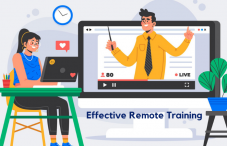Pandemic forced many companies to go digital. Right from remote hiring to remote working, most of the functions and activities were quickly moved online.
Several surveys have shown that remote working is here to stay. Many companies like Facebook, Spotify are letting their employees work remotely forever. Many others are implementing a hybrid model of working – remote and physically from office.
With the rise in remote working, it is important to have a strong strategy in place to train your employees remotely. While many companies are already utilising a mix of remote and physical training programmes, some were forced to start remote training due to the changing times especially the pandemic.
If you want to improve your remote training strategy, here are some essential tips that will help you plan your remote training better.
Tip # 1 Set Expectations
Be very clear about the goals and objectives of the training. Is it familiarizing the employees about the new BCP or is it in-depth training about the latest product or software?
Setting clear goals & expectations will help design the training material better and help motivate the participants to achieve what is expected from the training. It will also help you design means to test the learning outcomes.
Tip #2 Accessibility
Accessibility of the learning material is the key in the case of remote learning. Make the learning material available easily on platforms that work best with your employees. It can be in form of videos made available on the company’s intranet or a mobile app that can be accessed anytime, anywhere. It is also important to provide self-paced programmes which the employees can take up at the time when it best suits the employees.
Providing easy accessibility ensures that the participants do not lose interest mid-way and complete the programme on schedule.
Tip # 3 Engaging material
The biggest challenge with remote learning is that there is no one to physically check if the participants are engaged and able to understand what is being conveyed. There are many distractions and hence it is extremely crucial that the learning material is interesting and available in formats like short videos or with lots of illustrations and examples.
For eg. While explaining a new product, use screenshots from the demo or use the demo as a part of the video rather than explaining verbally.
There are many tools and applications available that can help design the most interesting and engaging training material. For eg. Canva allows you to create charts, collages, infographics. Screencast-o-matic helps you easily create, edit and communicate with videos and images.
Tip # 4 Create A Learner Community
Another challenge with remote working is the lack of sense of belonging. Employees usually feel isolated and do not relate to company goals and culture. In order to make Learning and Development work successfully for the remote employees, it is important to make the participants feel they are part of a learner’s community and simulate the non-remote learning environment.
One way to accomplish this is by creating discussion boards where participants can discuss their experiences about the learning topic. Also, encourage sharing & discussion of personal experiences and issues at the end of the programme to help reduce the feeling of isolation and make learning fun.
There are various communication tools like Slack, Zoom, etc that can be used to break the feeling of isolation and collaborate and communicate effectively during the training programme.
Tip # 5 Measure Effectiveness & Take feedback
No training programme is complete without a feedback session. Feedback is even more crucial for remote training since there is no physical interaction. It is important to measure the effectiveness of the training to see if the training objective has been met. It is also a good idea to get feedback on individual modules or sessions to make improvements if needed.
Try and incorporate a short survey, with questions that are easy to understand and reply to, after every module.
Remote workforce is growing and hence the requirement for remote training will increase at a significant rate.
Start planning, designing, and implementing effective & efficient remote training to keep your employee’s skills and motivation levels high, with the help of the above tips.
Looking for expert consultants to help you with your HR needs, get in touch with us now at https://www.flexiventures.in

